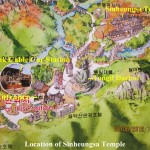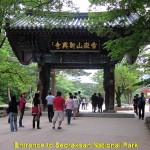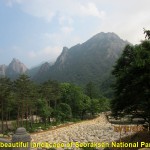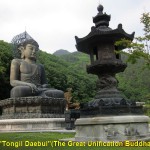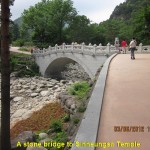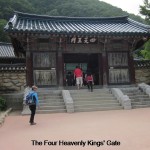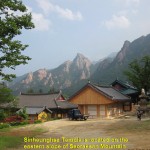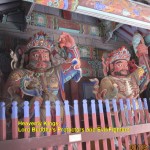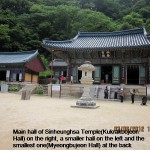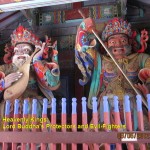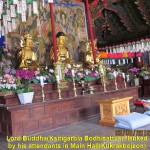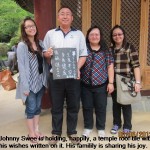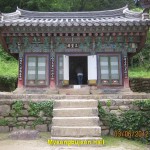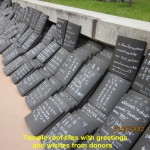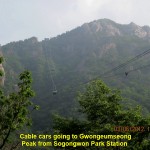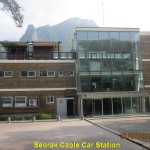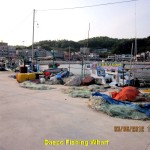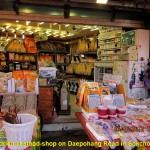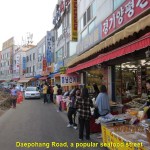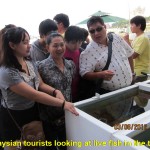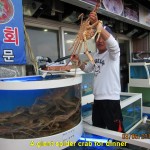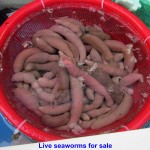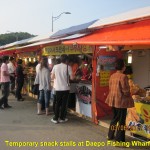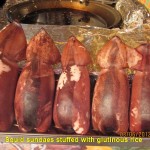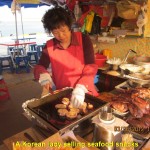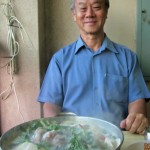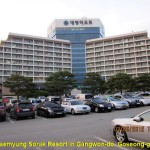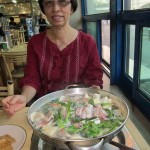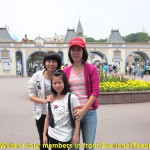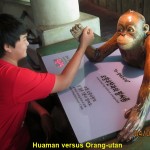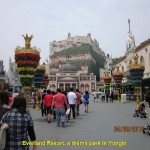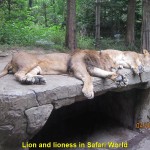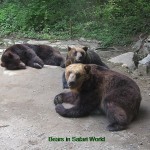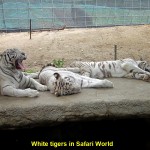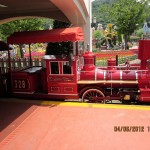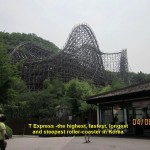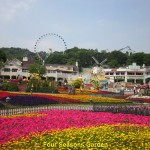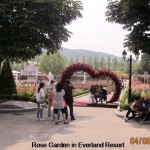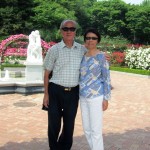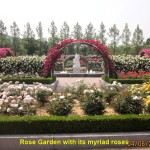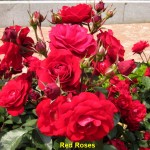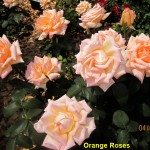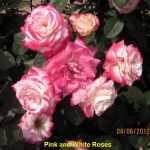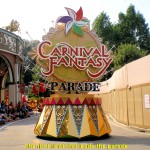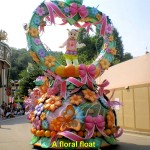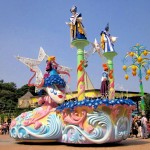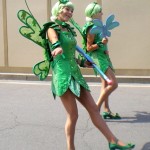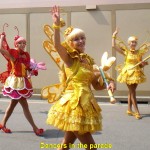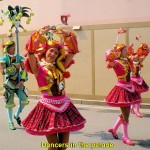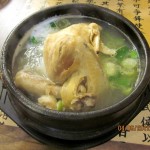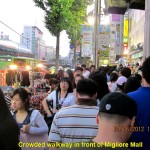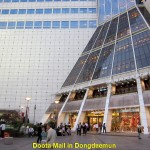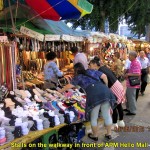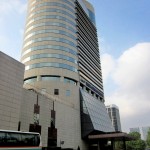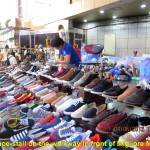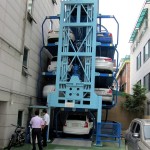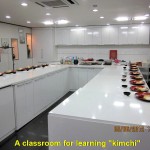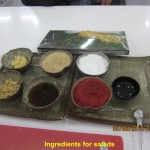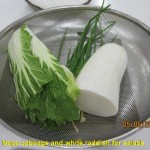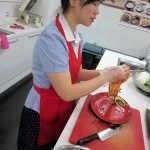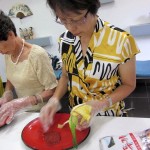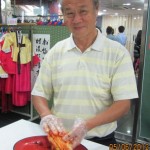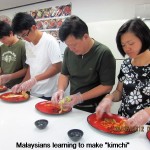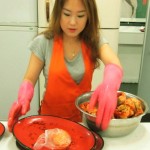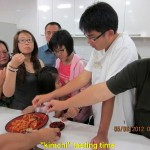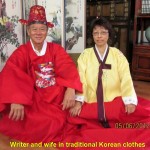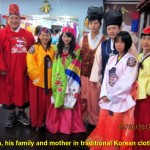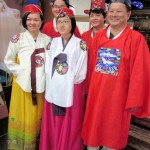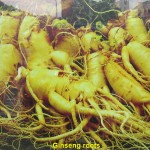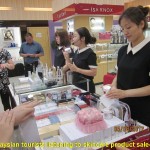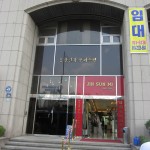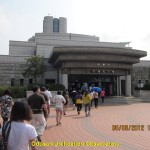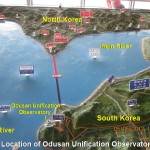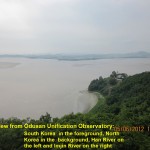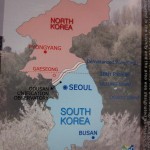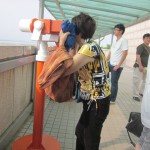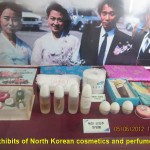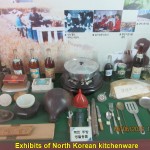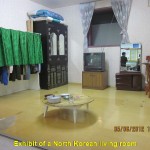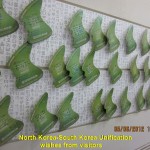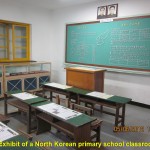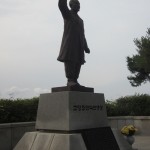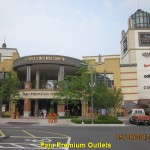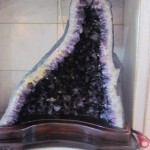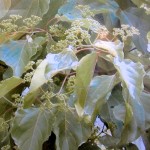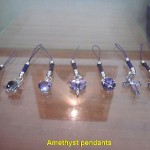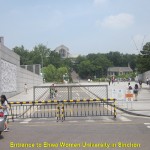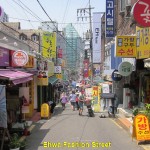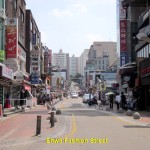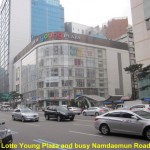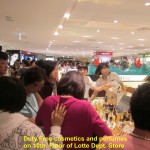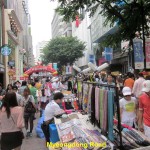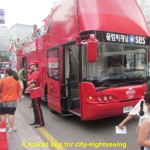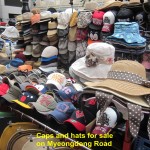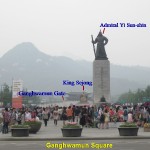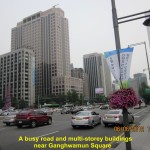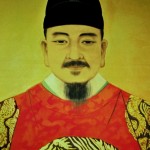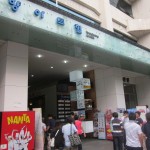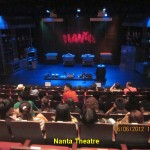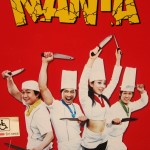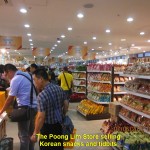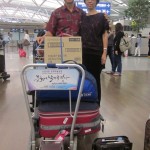South Korea Travel II
(continued from South Korea Travel I)
South Korea Travel II
Day 4 Sunday 3 June 2012
Flight back to Seoul City
At 9.45in the morning, we flew back to Seoul City. An hour later we arrived at Gimpo Airport in Seoul and boarded a tour-bus driven by Chow, a tall and quiet Korean man. He brought us to a restaurant for lunch. Then we left Seoul City and travelled a long journey to the east to visit one of the famous national parks in Korea known as Seoraksan National Park.
Seoraksan National Park
Located in the north-east of South Korea, Seoraksan National Park is a mountainous area of about 354 km² with many high granite peaks, lush valleys, hot springs and waterfalls. The highest peak in the area is Daecheongbong(1708 metres), the 3rd. highest in South Korea.
Seoraksan National Park is a serene and magnificent place, and popular among both local and foreign visitors, and climbers too. There are cable cars that bring visitors from Seorak Station to Gwongeumseong Peak where they can see breathtaking views of the park. The 1.5 km cable-car journey takes about 30 minutes.
Mountain-Hikers
When we arrived at Seoraksan National Park, we got out of our bus and walked to the oldest Buddhist temple in Korea. The temple is known as Sinheungsa Temple and about 800 metres from the main entrance. While walking to the temple, we saw many mountain-hikers coming back from a hill known as Ulsanbawi. This hill is a bare granite rock that has 6 small peaks that can be reached by climbing up 888 steps. Its height is about 873 metres and is about 4 km from the main entrance.
Tongil Daebul (The Great Unification Buddha)
Later, we came across a large bronze statue of Buddha. It was 14.6 metres high. He was sitting with his legs crossed on a lotus pedestal of height 4.3 metres. This statue was built with a good purpose: to wish that North Korea and South Korea would soon be reunited as a nation. Built at a cost of US$4.1 million donated by generous temple visitors and Koreans, it was aptly named as “The Great Unification Buddha” or “Tongil Daebul”.
Sinheungsa Temple
After crossing a white bridge over a dry river with rocks, we reached Sinheungsa Temple on the eastern slope of Seoraksan Mountain. Built in 653, it is the oldest Buddhist temple in Korea. Buddhism was spread to Korea in 372, i.e. 800 years after the death of Lord Buddha. In pre-Buddhist times, Koreans believed that spirits existed in mountainous areas. Later, when Buddhism arrived in Korea, these areas became the sites for Buddhist temples. It is surprising that today, the percentage of Buddhists in South Korea has dropped, sharply, to about 22 %.
Four Heavenly Kings
At the entrance of Sinheungsa Temple, there are four large painted fierce-looking statues who are supposed to be heavenly kings: King of the East, King of the West, King of the North and King of the South. Buddhists believe that they are Lord Buddha’s protectors and evil-fighters.
We walked through the entrance, under a long wooden building built on stilts, and saw the main hall of Sinheungsa Temple on a high ground. This hall is known as Kukrobojeon or Geukrakbojeon(Precious Building).
Kukrobojean or Geukrakbojeon(“Precious Building”)
Built in 1647, Kukrobojean houses a statue of Lord Buddha which is flanked by Avalokitesvara(“The Merciful Goddess”) on the left and Mahsthama-prata(“The Wise Goddess”) on the right. Although this building has been burned down and rebuilt a few times, its architectural style of the Joseon Dynasty(1392-1910) is maintained.
Temple Donations
At Sinheungsa Temple, one of our tour-members, Johnny Swee, donated some money to the temple and was given a new roof-tile to write his wish on. Written in Chinese, he wished his family good health, peace and harmony. We hope his wish will come true.
Many generous visitors had donated money to the temple as lots of new roof-tiles with their wishes written on them could be seen near the large statue of Lord Buddha, “Tongil Daebul”.
Cable-Car
Having seen the well-known temple, we walked back to our bus. On the way, I stopped at a cable-car station and watched for awhile a cable-car ascending to a peak known as Gwongeumseong Peak which was 860 metres above sea-level. From the peak, visitors could see a breathtaking panoramic views of the Seoraksan mountainous landscapes.
Daepo, Sokcho Town
Soon, we all left the cool and serene highlands, and travelled south-east to a fishing wharf, Daepo Wharf, in Sokcho Town. Twenty minutes later, we arrived at the wharf. As we were strolling along a street, Daepohang Road, near the wharf, we were amazed to see a row of shops selling all kinds of live and dried seafood, like crabs, clams, fish, sea-urchins, sea-cucumbers, prawns, squids, octopuses, etc. A visitor who loves seafood will be spoilt for choice there. Besides, he/she can choose live seafood in a shop, get them cooked and eat them at the shop, immediately.
An Unfortunate Incident
While we were in that narrow street, an unfortunate incident happened to a Malaysian tourist from another tour group. His right foot was run over by a wheel of a slow moving car. The kind driver of the car offered to send him to a hospital, but the latter declined his offer, as he thought his foot was not hurt, seriously. But many concerned people who were around him advised him to see a doctor, as soon as possible. We left the place without knowing the poor man’s final decision.
Seafood Snack-Stalls
We walked to another place nearby where there was a row of stalls selling seafood snacks. I noticed that all the stall-owners were old Korean ladies with light makeup. I guess it is a Korean culture for old ladies to look younger, clean and pretty with a little makeup.
My wife and I stopped at one of the stalls and bought a large squid stuffed with rice or squid sundae. It would be our supper that night.
Later, we left Daepo Wharf and went to a nearby restaurant where we had a delicious Korean seafood dinner. After that mouth-watering meal, we travelled westwards for about 20 minutes and arrived at a large resort on a high ground surrounded by scenic landscapes in Gangwon-dom, Goseong-gun. It was known as Daemyung Sorak Resort. We spent a very comfortable night there.
Day 5 Monday 4 June 2012
Everland Resort
After breakfast at Daemyung Sorak Resort, we travelled south-west for a few hours and arrived at Yongin City which is 43 km south-east of Seoul City. In this city, we visited the largest theme park in Korea known as Everland Resort. Opened in 1976, it boasts of five different zones for visitors of all ages. They are Global Fair, Zoo-Topia, European Adventure, Magic Land and American Adventure. It is comparable to any Disneyland in the world.
Safari World
On arrival at the theme park, our tour-guide, Angel, brought us to Zoo-Topia first. It has a mini-zoo where many kinds of animals, like birds, polar bears, sea-lions, penguins, tigers, primates and foxes, can be seen there. Then Angel brought us to Safari World where we queued up for 40 minutes for a bus ride in a fenced-up area to see lions, white tigers, bears and a liger(a hybrid cross between a male lion and a tigress). While we were on a slow moving-bus in that mini-safari, we saw many large animals having a siesta under trees along the road in the hot weather. We were quite excited when our bus was moving closer to some of them. For one moment we thought we were in a safari in South Africa.
Four Seasons Garden
After that safari experience, we went to a cafeteria to have lunch. Then we were on our own to explore the other places in Everland Resort ourselves. As my wife and I were walking further in, we saw a mini-train going round a colourful and beautiful garden, a garden of diverse flowers in full bloom. That area was known as “Four Seasons Garden”. To enjoy the sight of the whole garden comfortably, we sat on a mini-train that moved round it, slowly.
As we were coming out of the mini-train station, we, suddenly, heard loud sound of wood rattling and humans screaming at the top of their voices in a distance. Looking in the direction of the source of the noise, we were surprised to see a giant rollercoaster that looked like a monster. It was called “T Express”.
“T Express”
Opened in 2008, “T Express” is the highest(56m), fastest(max. 200 km/h), longest(1.8 km) and steepest(77°) roller-coaster in Korea. Besides, it is the first wooden roller-coaster built in Korea. Its loops, cock-screws, twists, turns and fast speed(max. 200 km/h) will undoubtedly make a rider feel shaken, dizzy and nauseous, after that three minute ride. But, there are four other roller-coasters which are less extreme than “T Express” in Everland Resort. Therefore, a visitor has a choice of one or more of them.
Rose Garden
As we had no courage for “T Express” ride, we went to a quiet but romantic place. It is another garden that grows nothing but roses, and is aptly called Rose Garden. In the garden, there are many colours of roses, but the most striking one is red. Many people like red roses, as they are attractive and considered as a symbol of love.
Even though it was early summer, we were very fortunate to see all the roses still blooming, beautifully, in Rose Garden. At the main entrance to the garden, there was a large arch in a shape of a heart covered completely with red roses. It was a favourite spot for young and old visitors to take photos.
When we entered the garden, we were mesmerized by a sea of roses of diverse species, sizes and colours. While strolling in the garden, we had a feeling of relaxation and peace, and a mood for romance and love. The rose flowers were so lovely that I could not stop clicking my camera away.
Carnival Fantasy Parade
Later, we waited near Rose Garden to watch a parade, “Carnival Fantasy Parade”. At 3 p.m. sharp, a loud music was played and the parade started. Over ten tall beautifully decorated floats which were carrying ladies and men dressed in colourful costumes were moving in a single file, slowly. Furthermore, each float was led by a group of pretty dancers in colourful and fashionable clothes dancing to the loud and lively music from loud-speakers placed along the parade route. Crowds were feeling excited and cheered loudly as the procession was moving slowly. That parade was the highlight of the day in Everland Resort.
Rotating House
After the parade, we walked to the main resort exit to meet up with our tour-members at 5 p.m. On the way, we chanced on an attraction known as “Rotating House”. When we entered the house and sat on a long bench, the lights went off. Then we had a spooky feeling in the darkness and did not know what to expect next. Most of the time we could hear two “ghosts” quarrelling, loudly, with each other, and saw dim coloured lights being switched on and off, frequently. Then, suddenly, we had a feeling that we were rotating in the house. It lasted for several minutes. When it was over we were glad to get out of that “haunted” house, quickly.
Looking at our watches, we realized that we had few more minutes left to meet up with the others at the exit gate. When all of us had gathered there, we left the theme park feeling tired but satisfied with the few unforgettable experiences we had there. Soon we travelled back to Seoul City and had a delicious dish of stewed chicken with a Korean ginseng root for dinner.
Dongdaemum Market
After dinner we went shopping at Dongdaemum Market or Great Gate Market. Located in Jongno-gu in the centre of Seoul City, it is a large commercial district that has traditional markets and shopping centres. Over 30, 000 specialty shops and 26 shopping malls are located there. Some of the malls open 24 hours daily. It is the most popular shopping area in Seoul and was designated as a Special Tourism Zone in 2002.
Owing to time constraint, our tour-guide, Angel, brought us to one popular shopping street only, Meokja Street. Along this street were some famous large multi-storey malls, like Doota, Migliore, and Hello apM. Besides, there were lots of stalls selling cheap merchandise on the walkways and along some streets. While we were there, the walkways, shops and malls were crowded with people. After spending a short time there, we left for a hotel, Seoul Olympic Parktel, in Songpa-gu in the city outskirt where we spent a night. That hotel was built in commemoration of the 1988 Olympic Games in the Olympic Park.
Day 6 Tuesday 5 June 2012
In the morning, we left Seoul Olympic Parktel Hotel early and travelled to a restaurant in Seodaemun-gu in north-east of Seoul to have breakfast.
On arrival at the restaurant, I was surprised to see a multi-parking machine or car multiparker which looked like a small ferris wheel. It allowed a total of 8 cars to park in it and helped to solve a parking problem at a place where parking space is scarce.
After breakfast at the restaurant, we went to a shop selling Koreans’ popular dish, “kimchi”. There is a Korean saying about “kimchi”. It goes like this: “A man can live without a wife, but not kimchi.” I wonder if this is true. I have yet to ask a Korean man about it.
“Kimchi”
Vegetables, like cabbages, radish, egg-plants, and cucumbers, are used for making “kimchi” in Korea. “Kimchi” is made by soaking a vegetable in salt-water overnight, mixing with various seasonings and then leaving them in a fridge for three weeks to ferment. A “kimchi”, usually, has five tastes: sweet, bitter, salty, sour and spicy. Among all the types of “kimchi”, “baechu kimchi” is the most popular. The vegetable for making this “kimchi” is napa cabbage(celery cabbage).
Two Simple Salad Dishes
When we entered the “kimchi” shop, we attended a “kimchi”-making class conducted by a lady-teacher. Before the lady began the lesson, she showed us the method of making two simple vegetable salad dishes. First, she cut a napa cabbage and white raddish into pieces and put them in two stainless steel bowls, separately. Then she mixed them with chilli powder, salt, oyster sauce, sesame seeds, ginger and garlic. Those two dishes looked like Malaysian “rojak”. The teacher told us that we would get to eat them after she had taught us the way to make “kimchi”.
“Kimchi”-Making Lesson
Standing at long tables with plates in front of us, each containing a piece of napa cabbage that had been soaked in salt-water overnight, and some “kimchi” dressing, we watched and listened, carefully, to the teacher’s instruction on the correct way of dressing up the vegetable and tying it up in a small bundle. We found that it was quite easy to do it. In a short time, all of us finished doing it and then went to the front table to taste the teacher’s salad dishes. Later, a pretty Korean girl went round collecting the “kimchis” we had made. The teacher told us that they would be kept in a fridge for three weeks to ferment before they were given away to old people staying at old folk homes in Seoul City.
Korean Traditional Clothes or “Hanbok”
After that interesting lesson, some of us bought a few packets of ‘kimchi” products recommended by the teacher. Then we were invited to wear Korean traditional clothes or “hanbok” with vibrant colours for a photo session in the shop for remembrance. Nowadays, Koreans wear them during traditional festivals and celebrations.
Korean “Ginseng” and Skincare Products
Later, we went to another shop which was selling Korean ginseng(“renshen” in Chinese).
Korean ginseng is well-known worldwide as an ancient tonic elixir and stamina builder. The Koreans claim that ginseng can remove toxic substances from blood, invigorate digestion, counteract cancer-causing free radicals and help the body maintain homeostasis(body stability). Ginseng is sold in either fresh, dried or powdered form. It is also sold as concentrated extract and granule types of tea.
When we arrived at the ginseng shop along Moraenae Road, we entered the building and were briefed about ginseng growing and its benefits by an employee. After that, some of us both a few boxes of ginseng, hoping that it would be good for health and stamina. Soon we left for another shop, Jin Sun Mi, which was further away. It was selling skincare products in different forms: creams, gels, liquids and powder. They were for treating skin problems, like pimples, wrinkles and blackheads, to name a few.
Odusan Unification Observatory
Later, we went to a restaurant for lunch in Seoul City. After that delicious Korean meal, we travelled north to a place close to the demilitarized zone(DMZ). It took us 40 minutes to reach the place where there is a 5-storey building on Odusan Hill of height 110 metres above sea-level. This hill is at the confluence of Imjin River and Han River. That building is known as Odusan Unification Observatory and was opened to public in 1992.
Demilitarized Zone(DMZ)
According to the history of Korea, North Korea and South Korea were separated at the 38th. parallel by Russia and the United States of America(U.S.A) after World War II(1939-1945). Russia took over North Korea whereas U.S.A. South Korea. Later, in 1948, the two countries were allowed to be ruled by their own new governments. Then in 1950 Korea War between the two countries broke out and ended in 1953 resulting in the creation of a demilitarized zone(DMZ) between the two countries. It is a buffer zone between North Korea and South Korea with a width of 4 km and length of 200 km from east to west. Until now the two countries still remain divided.
North Korean Side
Located on top of Odusan Hill, Odusan Unification Observatory offers a good view of the North Korean side, a distance of 2.1 km across Imjin River. With the aid of a few coin-operated binoculars in the outdoor on the 3rd floor, visitors can see close views of farms, roads, houses, flats, primary school, community hall, guard-posts, etc. on the North Korean side. Within the observatory building, exhibits of North Korean present way of life give a visitor an impression that the standard of living of the North Koreans is very low.
Unification Exhibition Hall
There is one hall on the 2nd. floor that is called Unification Exhibition Hall. In this hall visitors can read about the events happening between both countries since they were separated, such as a South Korean warship sunk by the North in 2010, Yeonpyeong Island attacked by the North, two battles of Yeonpyeong, talks between the two countries on unification, North Korean nuclear program, exchange visits of separated families and art performance groups, outbreak of the Korean War(1950-53), economic co-operation, North Korean missile launches, and many more. Although both countries have many talks for many years, they are still divided.
Wish Room
Next to this Unification Exhibition Hall is a small room, Wish Room, where a visitor can write on a green card a wish that both North and South Koreas will soon reunite as one nation and hang it among other written ones on the wall. While I was inside, I took a blank card and wrote the same wish that both countries would reunite soon.
When we got out of the Odusan Unification Observatory, we had a sad feeling that Korea had been separated for 67 years and not reunited yet.
Statue of Jo Man-sik
As we were walking to our bus, we came across a dark statue of a man standing on a high pedestal. According to an information on a board next to it, the man was known as Jo Man-sik whom the South Koreans considered as a martyr. The South Korean government erected the statue there in honour of Jo’s attempt to promote democracy in North Korea. Besides, it awarded him the Order of Merit for National Foundation in 1970, posthumously.
Jo Man-sik
Jo Man-sik was born in 1883 in North Korea during the Japanese imperialism. He was an activist in the Korea’s independence movement against the Japanese rule. After World War II in 1945, Soviet Union ruled North Korea. While he was living in North Korea he opposed to communism and promoted democracy. Later, he was arrested by the Soviets and put into a prison together with others who opposed the communist ideology, too. It is believed that Jo was executed in 1950 in the prison. When Jo died, his opponent, Kim Il-sung, backed by Soviet Union got the chance to rule North Korea for 48 years. The later died in 1994 and was succeeded by his son, Kim Jong-il, and later grandson, Kim Jong-un, in 2011.
Paju Premium Outlets
The next place we went to was Paju Premium Outlets. Located in Paju near Odusan Unification Observatory, it houses over 150 outlets selling duty-free goods of well-known brands in the world at cheaper prices. Visitors to these outlets are spoilt for choice. They can buy shoes, sportswear, luggage, designer fashions, accessories, jewellery, housewares, home furnishings, and intimate apparel, just to name a few.
Having spent over an hour at the outlets, we left for Seoul City where we had dinner. After dinner, we went back to Seoul Olympic Parktel Hotel where we spent another night.
Day 7 Wednesday 6 June 2012
Korean Amethyst Manufacturing
In the morning, after breakfast, we went to a jewellery shop at 136, Worldcupbuk Road known as Korean Amethyst Manufacturing. It uses amethyst, a purple gemstone, to make many kinds of jewellery, like rings, necklaces, ear-rings, pendants, bracelets, etc. Some of us bought cheap ones for remembrance and as gifts.
After spending a short time there, we went to another shop that was selling a health product made from extract of Hovenia dulcis fruits or oriental raisin tree fruits. According to a shop-employee, it could help to protect human livers against harmful substances, e.g. alcohol.
Fashion Street
After a short visit to the two shops, we went to a small shopping area near Ehwa Woman’s University in Sinchon. Known as Fashion Street, it has many streets lined with small shops selling mostly ladies’ goods, like clothes, shoes, handbags, belts, accessories, etc, and offering nail and hair services. It is a popular place among the female students from the nearby university as the prices of the goods suit their pockets. This small, colourful and charming place is now a tourist attraction.
Myeongdong Shopping District
We spent over an hour at Fashion Street before we went to a Chinese restaurant in Seoul downtown for lunch. Later, we went to one of the oldest and largest shopping districts in Seoul City, Myeongdong Shopping District. It is a popular tourists’ shopping area where many multi-storey shopping buildings, commercial banks, hotels, restaurants, cinemas, theatres and historical sites are located. Everyday hundreds of thousands of visitors, foreign and domestic, visit this area.
Lotte Duty Free Products
When we arrived in Myeongdong Shopping District, Angel, our Korean tour guide, brought us to some duty free shops on 9, 10 and 11th. floors of a tall building known as Lotte Department Store along Namdaemun Road. Well-known world brands of clothes, shoes, handbags, watches, cosmetics, perfumes, jewellery, electronic goods, etc. in those shops were sold at duty free prices for foreign tourists only. As the three floors were very crowded with tourists, we, men, just watched our spouses browsing at some shops selling cosmetics and perfumes on the 9th. floor.
Myeongdong Road
Later, we went to Myeongdong Road near Lotte Department Store. That long road was closed to traffic, and small stalls were set up in the middle and both sides of the road. The road was already crowded with people when we arrived there. Many kinds of things were sold there, ranging from socks, shoes, accessories, sunglasses to handbags and apparels. They were inexpensive, but their qualities were questionable.
Ganghwamun Square
After spending a few hours in the Myeongdong Shopping District, we went to Ganghwamun Square which is a short distance away. At the square there were quite a lot of people. This area is right in front of Ganghwamun Gate which is the main gate of the ancient palace, Gyeongbokgung Palace.
King Sejong the Great(1397-1450)
At the square, there are two large statues of prominent Korean figures. The one nearer to Ganghwamun Gate is a statue of King Sejong. King Sejong(1397 – 1450) was the fourth king of the Joseon Dynasty. He was well-known for his creation of the Korean writing system, “Hunmin Jeongeum”. Furthermore, he had made some significant contributions in science and technology, reinforced Korean Confucian policies, executed major legal amendments, and expanded his territory. Later, after his death, he was known as King Sejong the Great.
Admiral Yi Sun-shin(1545-1598)
The other statue which is further away from the gate is a figure of Admiral Yi Sun-shin. Admiral Yi(1545 – 1598) was one the Korean greatest heroes. During the Japanese invasions of Korea(1592 – 1598), he defeated the Japanese navy over twenty times, to the admiration of his own people and the Japanese admirals too.
Gangbuk Jeongdong Nanta Theatre
Later, we went to Gangbuk Jeongdong Nanta Theatre to watch a unique but noisy performance. It was a small theatre inside a building known as Kyunghyang Art Hill that is along Saemunan Road. The performance involves 5 persons: Manager(Dae Ho Kim), Chief Chef(Sung Dong Jo), two assistant cooks(Soo Hui Koo and Na Jun Seok), and the manager’s nephew(Woo Rin Na).
Nanta Story
The story of the show is a simple one: When the cooks are told by their manager to prepare and get ready a wedding meal in an hour’s time, the cooks turned the kitchen into a turmoil making a lot of noise with their knives, chopping-boards, and other utensils, but the noise soon became music to our ears and was entertaining. Although the performers did not talk much, their silly actions kept the audience laughing all the time.
After that 1½ hour hilarious Nanta show, we left for dinner at a restaurant nearby, and later we left for our hotel where we retired for another night.
Day 8 Thursday, 7 June 2012
The Poong Lim Store
We woke up early in the morning today, as we had to catch a flight home at 8.20 a.m.(Korean time). On the way to Incheon International Airport from Seoul, we stopped at a restaurant in Incheon where we had our breakfast. After breakfast we shopped for some Korean snacks and tidbits at The Poong Lim Store on a lower floor(below the restaurant). Many of us bought boxes of them as we wanted to give them away to our loved ones and friends in our country.
Departure for Home
Soon we were at the airport and felt happy that we had a wonderful and unforgettable trip in South Korea. Besides, we were glad that we were going home then as we had been away for 8 long days.
Finally, at about 8.30 a.m. we were up, up and away from South Korea to our homeland(Malaysia) bringing along with us a lot of experiences and knowledge about Korean history, tradition, culture, natural landscapes, shopping districts, etc..
Well, that is all about my enjoyable and interesting South Korea tour, and I hope to travel to some places in another country soon.
Acknowledgement
Thanks to SA America Travel Corp(J) Sdn. Bhd., Johor Bahru for that wonderful Korea tour. I would also like to thank our tour leader(Irene Lee), tour guide(Angel), and the two tour bus-drivers(Chow and Ko) in Korea for their excellent services. Without all of them, our tour would not have been possible and successful.
Thanks also to all my tour members for their care, understanding and companionship during the tour.
The End
Written by Choo Chaw, Kluang, Johor, Malaysia

